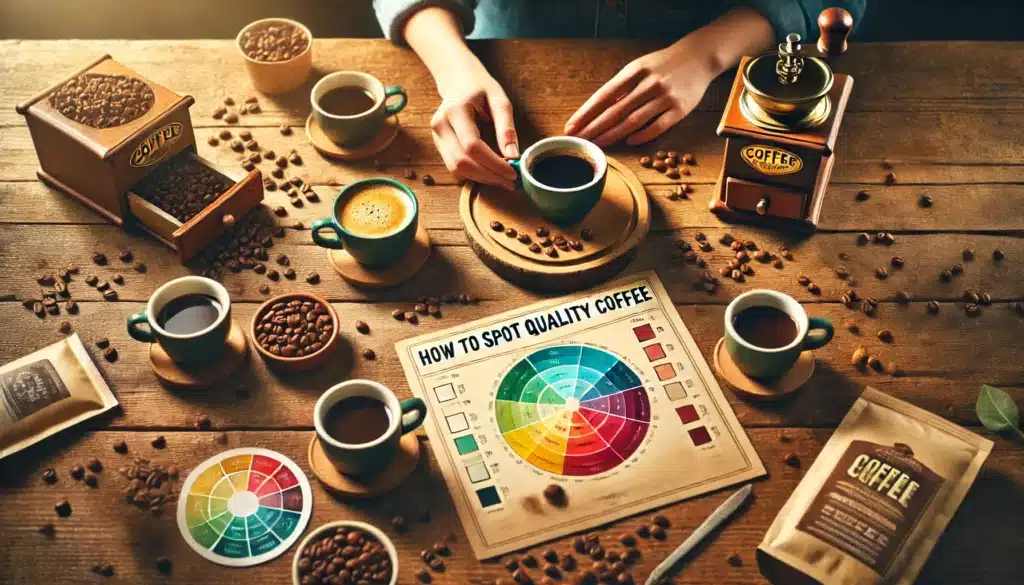Not sure how to tell if your coffee is good or just… average? Don’t worry — recognizing quality in coffee isn’t reserved for experts. With a little guidance and curiosity, anyone can learn to identify great coffee using their senses and a few key indicators.
This beginner-friendly guide will help you spot quality coffee — before and after the first sip.
1. Check the Bean Appearance
Start with whole beans if possible. High-quality beans are:
- Even in size and color
- Free of defects or broken pieces
- Fresh-looking with no oil slicks (except on some dark roasts)
Avoid beans that look pale, scorched, cracked, or overly shiny.
2. Look at the Roast Date
Freshness matters. Look for a roast date, not just an expiration date.
- Ideal window: 7 to 30 days after roasting
- For espresso: wait 5–7 days post-roast
- Avoid coffee roasted months ago or with no visible date
Freshly roasted beans retain more flavor and aroma.
3. Smell the Aroma
Before brewing, take a moment to smell the dry grounds. A quality coffee should have:
- Inviting, complex aromas
- No mustiness, staleness, or chemical smell
You might detect fruity, nutty, floral, or chocolate notes — all signs of a well-grown and roasted coffee.
4. Observe the Brewed Color
After brewing, observe the color of the coffee:
- A rich amber or deep brown usually signals balanced extraction
- Pale or cloudy brew could mean under-extraction or stale coffee
- Overly dark or oily can suggest over-roasting or bitterness
Visual cues are subtle but helpful.
5. Taste for Balance
Good coffee has balance — no single element should overwhelm the others.
Ask yourself:
- Is there acidity without harshness?
- Is the bitterness pleasant, not overpowering?
- Is there sweetness or roundness?
Quality coffee is like a well-mixed song: everything plays in harmony.
6. Evaluate the Body
“Body” refers to the texture or weight of the coffee in your mouth.
- Light body: like tea or juice
- Medium body: smooth and silky
- Full body: thick, creamy, or syrupy
A good coffee’s body should feel pleasant and appropriate for its origin and roast.
7. Notice the Aftertaste
Pay attention to what lingers after the sip.
- A clean, lingering finish is a good sign
- Harsh, dry, or burnt aftertastes can signal poor roasting or bad beans
- Fruity or floral aftertastes are common in high-end coffees
Quality coffee leaves you wanting another sip.
8. Read the Label Details
Great coffee brands provide transparency. Look for info like:
- Origin (country, region, altitude)
- Variety (e.g., Bourbon, Typica, SL28)
- Processing method (washed, natural, honey)
- Roaster notes or tasting descriptions
The more details, the more likely it’s a traceable, thoughtfully sourced coffee.
9. Choose a Trusted Roaster
Not all coffee is created — or roasted — equally. Look for:
- Small-batch or specialty roasters
- Direct trade or relationship-based sourcing
- Freshness guarantee and roast-to-order options
Reputation, transparency, and customer feedback matter.
10. Trust Your Own Palate
Ultimately, a quality coffee is one that tastes great to you.
As you taste more and note your preferences, you’ll begin to recognize:
- What you love
- What you want to avoid
- What makes coffee exciting and personal
Your palate is your best guide.
Final Thoughts: Learn by Tasting
Identifying quality coffee is a journey of discovery — and it starts with observation, intention, and enjoyment. The more you pay attention, the more you’ll notice the details that make a good coffee great.
Taste often, ask questions, and most importantly — enjoy every cup.







